There are many different species of venomous spiders in Ohio, and each one has its unique characteristics. Many of Ohio’s spiders with venom don’t have enough poison in their bite to cause serious harm to people. Yet, they can absolutely kill various insects and other prey.
Spiders are arachnids, which are a type of arthropod. They have eight segmented legs and make sticky silk for mobility, shelter, and trapping prey. Most spiders also have fangs that inject venom when they bite. Their venom serves two possible functions: to harm tissue around the bite area or to shut down the nervous system of their prey or predators.
Keep reading to discover three venomous spiders in Ohio that could seriously harm a human. Plus, we’ll discover three additional spiders that could cause mild to moderate symptoms from their bite.
1. Black Widow Spider
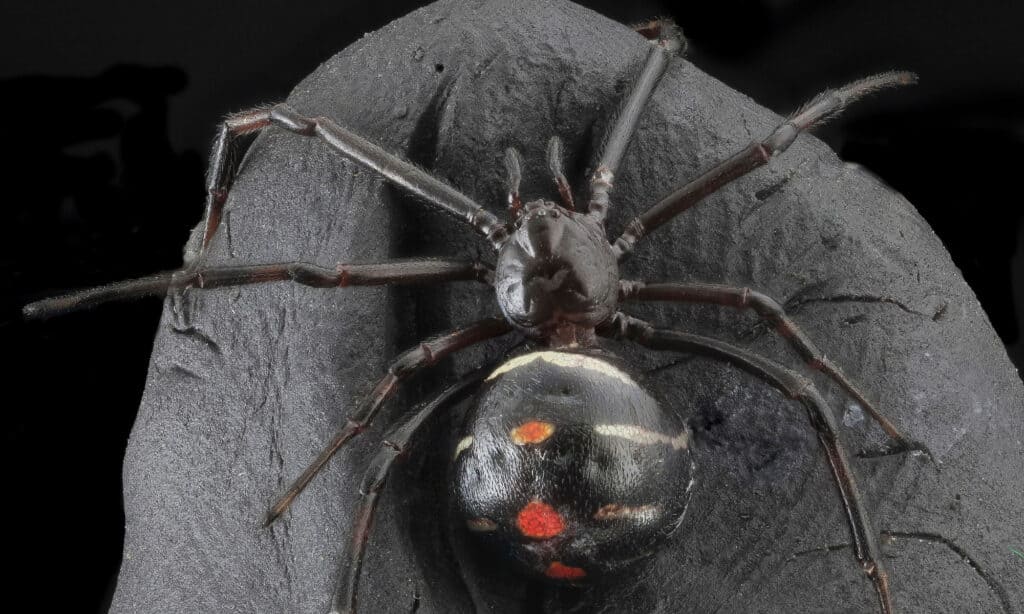
Black widows are dangerous spiders in Ohio.
©Porco_Rosso/Shutterstock.com
The black widow spider (or Latrodectus) is one of Ohio’s most dangerous venomous spiders. This spider is tiny, but its venom is powerful. Black widow bites can cause severe pain, nausea, vomiting, muscle cramps, and even paralysis. Other symptoms could include sweating, leg tremors, and swollen eyelids. In some cases, black widow bites have been fatal. If this dangerous spider has bitten you, consider it an emergency requiring immediate medical attention.
The good news is black widow spiders are not aggressive and will only bite humans if they feel threatened or if their web is disturbed.
Black widow spiders are typically shiny and dark-colored with a distinctive red or orange hourglass-shaped mark on their abdomens. These spiders are relatively small, with adults ranging in size from about 5 to 10 mm. Black widows are shy, reclusive spiders and are most active at night. They build their webs in secluded areas such as garages, woodpiles, crawl spaces, and sheds.
Black widow spiders primarily feed on insects like beetles and caterpillars. They are generally nocturnal hunters and will build their webs near areas where they know there will be a good supply of food. Black widow spiders are not particularly discriminatory in what they eat – they will capture and consume just about any insect caught in their web. This practice makes them very effective at controlling local insect populations. While black widows typically only eat live prey, they occasionally feed on carrion.
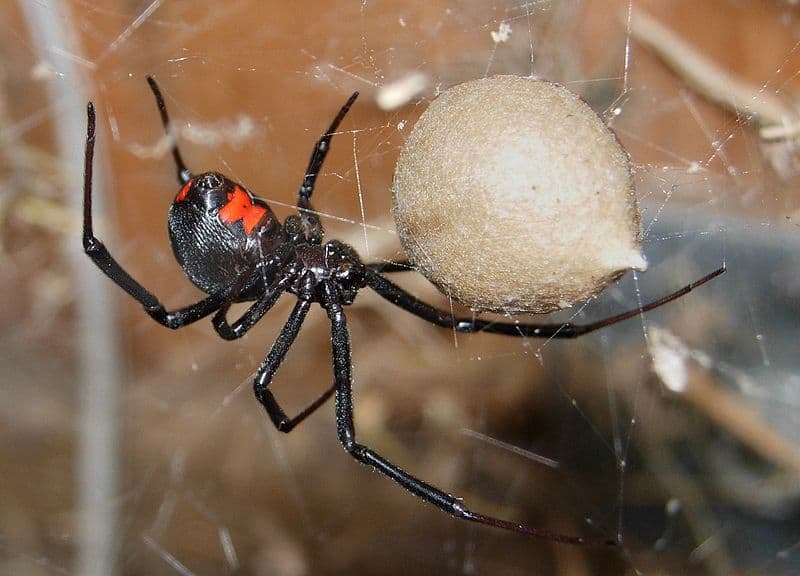
Female black widows tend to eat males after they mate.
©Chuck Evans(mcevan)”./ CC BY 2.5, via Wikimedia Commons – License
Male and female black widows are different in a few key ways:
- Female black widows are typically larger than males, so their venom is more potent.
- Female black widows often have a smaller web, which means they are more likely to bite humans who invade their space.
- Female black widows are more aggressive when defending their territory.
The above factors make female black widows significantly more dangerous than males.
While male black widow spiders are venomous, their bites are usually not fatal to humans. Female black widow spiders, on the other hand, can be deadly.
Yet, humans aren’t the female’s primary target. Black widow males have a much shorter lifespan than females because they’re usually killed and eaten by their mates. The male spider’s fate is the reason for this species’ common name (“widow”). The lifespan of these venomous spiders can be up to 5 months for males and 18 months for females.
2. Brown Recluse Spider

The brown recluse has six eyes, unlike other spiders.
©Nick626/Shutterstock.com
The brown recluse is a dangerous venomous spider in Ohio, but it’s rarely identified correctly. For this reason, brown recluse sightings and bitings aren’t as common in Ohio as people might think. Brown recluse spiders are different than black widows. They’re slightly smaller and are much more reclusive, but their venom is also very potent. Brown recluse bites cause severe tissue damage; in some cases, the venom can cause human death.
Brown recluse spiders are small, brown, and have a violin-shaped mark on their back. They are usually about 6-12 mm in length. One of the most distinguishing features of the brown recluse is its eyes. This spider has six eyes arranged in three pairs. Most spiders have eight eyes.
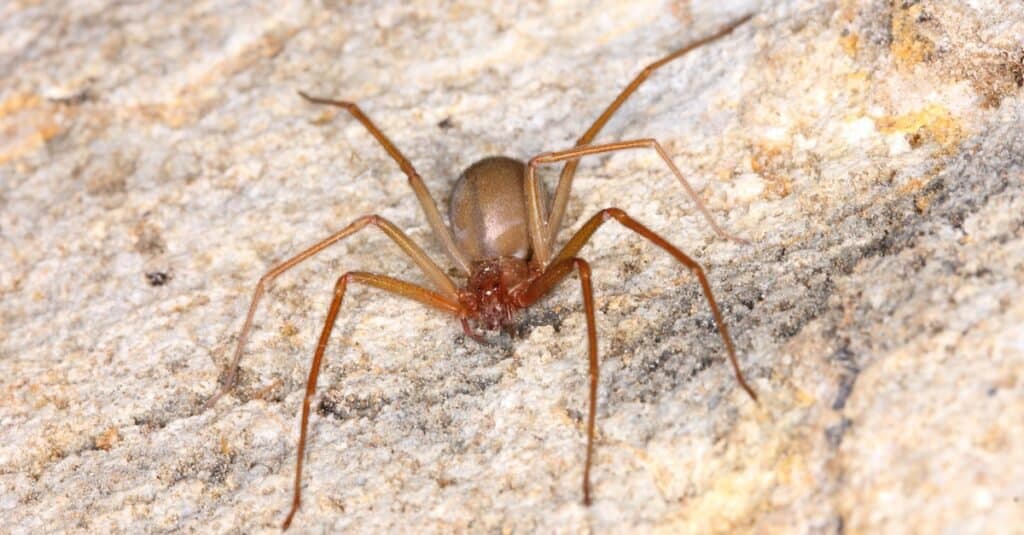
The brown recluse spider is one of the most dangerous spiders in the United States with venom that destroys the walls of blood vessels near the site of the bite, sometimes causing a large skin ulcer.
©Pong Wira/Shutterstock.com
These spiders are usually found by humans only during their mating season, as the males are walking around seeking mates. Brown recluse spiders are nocturnal, but the males might rest or take refuge in piles of clothing during daylight hours. They are not aggressive spiders but will bite to defend themselves when they feel threatened.
Brown recluse spiders are often misidentified because they are not as well known as other spider species. You’ll recognize a bite from this spider by the red ring on the skin around the bite area. Over several hours, the bite area might become an open sore. This open sore is a sign of tissue damage and requires immediate medical attention. Other brown recluse spider bite symptoms include chills, fever, and increasing pain.
3. Mediterranean Recluse Spider

Despite not being native to Ohio, the Mediterranean recluse spider has toxic venom.
©Malpolon/Shutterstock.com
The Mediterranean recluse spider is a dangerous venomous spider not native to Ohio. But over time, this invasive species made its way to Ohio and other states, usually after being transported in shipments of goods from other countries.
The Mediterranean recluse spider’s venom is highly toxic and can cause serious health problems, including death. Symptoms of a bite include severe pain, swelling, and necrosis (tissue death). And these symptoms come on quickly, sometimes within a couple of hours. So if a Mediterranean recluse spider bites you, it is important to seek medical help immediately.
The Mediterranean recluse is similar to the brown recluse in size and appearance. These spiders are small, brown, and have a violin-shaped mark on their back. The females typically grow up to 8 mm long. The Mediterranean recluse spider has only six eyes like the brown recluse spider.
In its natural habitat in the Mediterranean, this recluse spider is a cave-dweller. It prefers to live in dark, secluded areas like caves, tunnels, garages, and sheds. Unfortunately, this spider also loves to rest in piles or stacks of cardboard.
4. Yellow Sac Spider
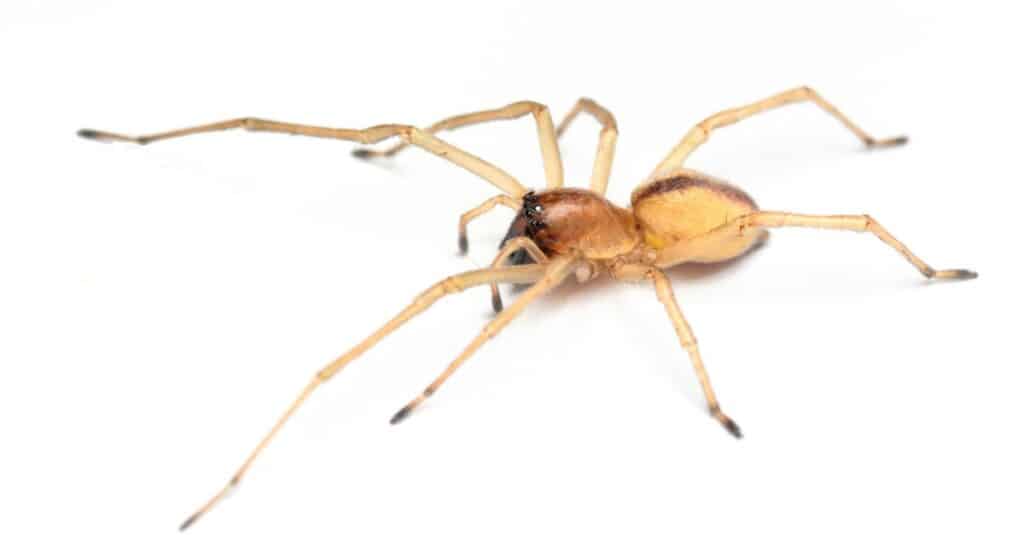
Yellow sac spiders are active hunters that build webs to catch prey.
©D. Kucharski K. Kucharska/Shutterstock.com
The yellow sac spider is a venomous arachnid in Ohio that is moderately dangerous to humans. Its bite comes with pain similar to a hornet sting. A skin blister and mild illness are also common symptoms of this spider’s venomous bite.
Yellow sac spiders get their common name from the yellowish color of their egg sacs, but the spider’s body is sometimes pale green. They are generally small, with adults ranging up to 10 mm in length.
The yellow sac spider is a predator of insects and other arachnids. It’s known as a prowling spider and runs very quickly. These spiders are active hunters that build webs to capture their prey. Yellow sac spiders will also feed on plant material if they cannot find other food sources.
Some people consider yellow sac spiders nuisance pests. These spiders are not aggressive but quick to defend themselves if they’ve been hiding in the sweater you just pulled on. They love lounging in a pile of laundry, as many spiders do.
According to Washington State University’s Department of Entomology, elevate and apply ice to the bite area if a yellow sac spider bites you. Get medical attention if symptoms like mild illness get worse, as some people are allergic to this spider’s venom.
Yellow sac spiders are relatively easy to control. If you have these pests in your home, you can remove them with a vacuum cleaner or by using insecticide sprays. Seal cracks or openings in your home that these spiders could use to enter. It would be best if you also kept your home free of clutter, as yellow sac spiders like to hide in dark and sheltered areas.
5. Zebra Jumper Spider
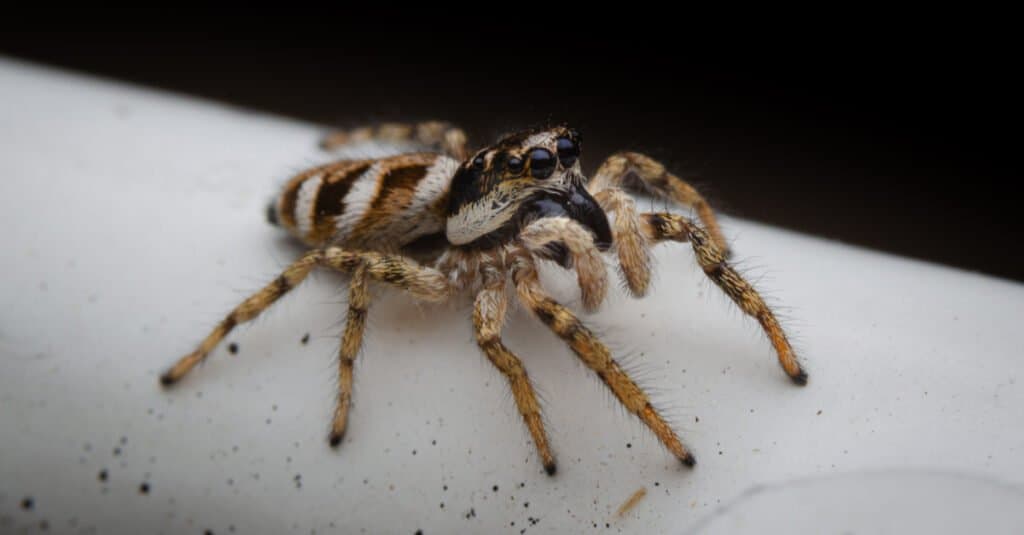
The zebra black spider has excellent binocular vision.
©Mario.Pieper/Shutterstock.com
Though the zebra jumper has venom, a bite from this venomous spider in Ohio is rarely dangerous to humans. And no – these spiders don’t jump over zebras all day! Instead, the zebra jumper is named for its striking zebra-like coloring of black and white stripes. This spider is common in the northern hemisphere, including the state of Ohio.
Zebra jumpers are small spiders, only about 9 mm long. They are easy to spot by their black and white striped bodies and large, bulbous eyes. Zebra jumpers don’t build webs to catch prey. Instead, they hunt down other insects and spiders to eat.
The zebra jumper catches its prey by jumping on it, but only after anchoring itself to a surface with a string of its silk. If it jumps toward the mark and misses, the zebra jumper climbs the string of silk back to its anchor spot to start the hunt again.
Though zebra jumper bites are usually not dangerous to humans, they can cause redness, swelling, and itchiness at the bite site. Most zebra jumper bites are mild and rarely more irritating than mosquito bites or more painful than a slight bee sting.
Zebra jumper spiders are not aggressive and will only bite humans if they feel threatened. However, these spiders are more likely to bite if they are accidentally squashed or squeezed.
6. Spitting Spider
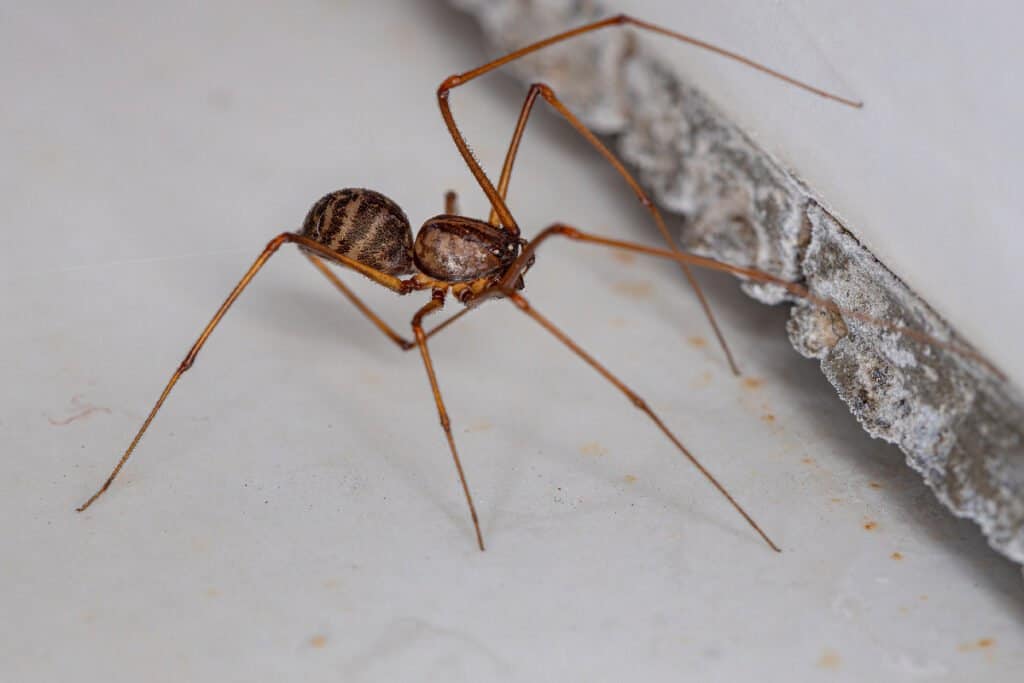
The spitting spider catches prey with venomous silk that it shoots from its abdomen.
©iStock.com/ViniSouza128
The spitting spider is a type of arachnid in Ohio known for its ability to shoot or “spit” a stream of venomous webbing at its prey. These spiders originated in tropical and subtropical regions around the world, like Africa, Central America, and the Caribbean. Their diet is full of insects, such as mosquitoes and flies. So if your Ohio property has spitting spiders, you’ll likely have fewer bothersome insects flying around!
Spitting spiders aren’t aggressive to humans and don’t pose a health risk. However, as with most spiders, it’s best to leave them alone.
When a spitting spider feels threatened, it will first try to retreat. If that is not possible, it will turn to face its attacker and release a stream of sticky and venomous webbing. This webbing can immobilize prey, and the spider will then move in to deliver a fatal bite. Attacking by spitting venomous silk is also how the spitting spider hunts its prey.
Spitting spiders are relatively small, with adults typically measuring less than 6 mm in body length. They are brown or gray, with bodies covered in hair. Like recluse spiders, spitting spiders have six eyes.
Take Caution With Venomous Spiders In Ohio
Though some of the species of venomous spiders in Ohio are capable of causing serious harm to humans, usually only two species – the widows and the recluses – cause life-threatening symptoms. Be aware of these spiders’ dangers and take steps to avoid them.
There are a few things to look for if you think you may have been bitten by a venomous spider, whether you live in Ohio or anywhere else. First, check for two puncture marks where the spider’s fangs would have penetrated the skin. Redness or swelling around the bite site is another sign of a venomous spider bite. You may also experience pain, itching, and burning at the site of the bite, in addition to more severe symptoms like vomiting, tissue death, and paralysis. If you experience any troubling symptoms resulting from a spider bite, it is crucial to seek medical attention immediately.
And if you love spiders, check out our article on the top 10 biggest spiders in the world!
The photo featured at the top of this post is © Porco_Rosso/Shutterstock.com
Sources
- Ohio State University (1970) osumarion.osu.edu/SpiderWeb/Ohio'sBitingSpiders.htm
- Nbc4i, Available here: https://nbc4i.com/news/be-vigilant-ohio-man-bit-by-venomous-brown-recluse-spider/
Thank you for reading! Have some feedback for us? Contact the AZ Animals editorial team.






